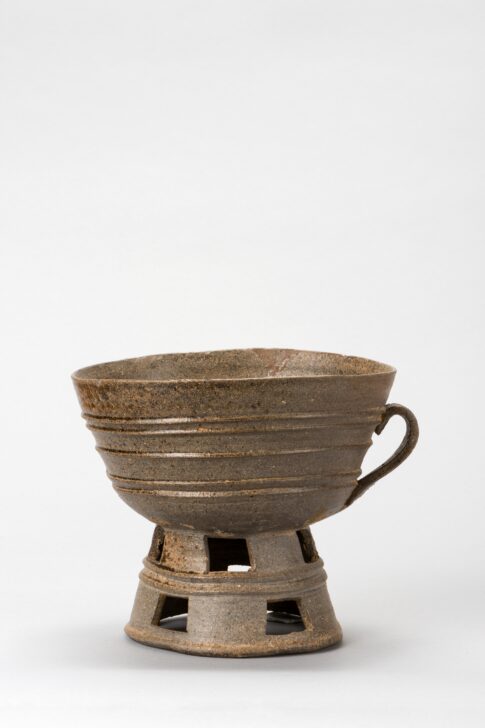Pedestal Cup or bowl with handle, on cut-out pedestal foot
Korean

Description
The function for this enormous bowl or cup is unknown. A vessel very similar to this one was excavated in the 1920s from a tomb near Daegu, which lies to the north of the Silla capital of Gyeongju. The tomb has been dated to ca. 500 C.E., which provides an estimate for the date of this piece as well.
Maribeth Graybill, The Enduring Art of the Korean Potter, December 12, 2004-November 6, 2005
Subject Matter:
Footed bowl was found in the Three Kingdom and Unified Silla. It is one of the ritual vessels. It can be found in every tomb of that age. It is almost grayish-blue stoneware. At the beginning, It didn’t have lid and perforation. From 4C lid and perforation was made. Footed bowl is divided Silla style and Gaya style. The lid and bowl of Silla style are thick and the leg is slim. The perforation is located in altering position. In contrast, the lid and bowl of Gaya style is very flat and the leg is thick. The perforation is positioned in parallel.
Physical Description:
It has deep cylindrical bowl supported by a little flared pedestal foot. Five raised band lines encircle the middle of the bowl. A single handle is attached to the body of the bowl. The foot is separated into two parts and has a lot of rectangular holes located in altering position. There is no design on the surface of the bowl and foot.
This is a grayish white, high-fired stoneware pedestal bowl which is colored greenish-brown in places due to the formation of natural glaze. The bowl flares widely at its top and has a round base. Its outer surface is surrounded by five horizontal ridges which are arranged in three sets: two at the top, one in the middle and two at the bottom. The pedestal spreads outwards in a straight line and is divided into two sections by a set of two raised bands in its center. The upper and lower sections of the pedestal each contain five square perforations that are alternately offset from one another. The base edge of the pedestal is round and does not protrude much.
[Korean Collection, University of Michigan Museum of Art (2017) p. 67]
Usage Rights:
If you are interested in using an image for a publication, please visit https://umma.umich.edu/request-image/ for more information and to fill out the online Image Rights and Reproductions Request Form.